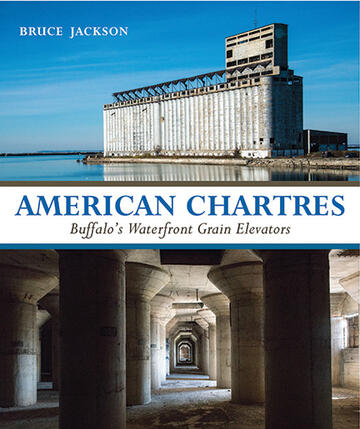
American Chartres
Buffalo's Waterfront Grain Elevators
Alternative formats available from:
Documents the city’s surviving grain elevators and their profound influence on twentieth-century architecture.
Description
On a visit to Buffalo, New York, the French poet Dominique Fourcade was awed by the huge concrete grain elevators that line the city's river and lakefront. Turning to his guide, the poet Susan Howe, he exclaimed, "The American Chartres!" Taking Fourcade's exclamation as its title, Bruce Jackson's American Chartres documents Buffalo's surviving grain elevators, capturing these monumental buildings in all seasons and in various light; from the Buffalo River, the Ship Canal, and Lake Erie; from inside and from the top floors and roofs; in detail and in toto.
Invented in Buffalo by Robert Dunbar and Joseph Dart, the city's first grain elevator went operational in 1843. By the mid-1850s, Buffalo was the world's largest grain port, and would remain so well into the twentieth century. Grain elevators made Buffalo rich, and they were largely responsible for the development of the Port of New York.
While primarily functional objects, designed to move grain from one transportation modality to another, grain elevators are also beautiful structures, and they exerted a profound influence on many twentieth-century architects. Walter Gropius, one of the founders of the Bauhaus, collected photographs of American grain elevators and published two of Buffalo's elevators in 1913. The great Modernist architect Erich Mendelsohn came to Buffalo to photograph them in 1924, and they also influenced the practice of architects such as Le Corbusier and the Italian futurist Antonio Sant'Elia. More recently, the conceptual artists and photographers Bernd and Hilla Becher have included grain elevators in their documentation of industrial structures in Europe and North America.
Despite their deep impact on twentieth-century architecture, Buffalo's grain elevators remained underappreciated. As they outlived their economic usefulness, many were destroyed. Only recently have local residents realized what treasures they are. Beautifully illustrated with more than 160 color photographs, this book documents what remains.
An accomplished author, photographer, and filmmaker, Bruce Jackson is SUNY Distinguished Professor and James Agee Professor of American Culture at the University at Buffalo, State University of New York. He is also codirector of the university's Creative Arts Initiative. His numerous books include Inside the Wire: Photographs from Texas and Arkansas Prisons.
Reviews
". ..this book is a show stopper. " — RALPH: The Review of Arts, Literature, Philosophy, and the Humanities
". ..[an] evocative and memorable collection of photographs. " — ArtVoice
"The author skillfully captures these landmark buildings in all seasons and in various light. After even a cursory glance at this impressive work, you'll want to experience for yourself a close-up view from one of the Buffalo River and Harbor boat tours that include these architectural wonders along that waterfront. " — Niagara Gazette
". ..an astonishingly beautiful document of form: Jackson, an accomplished social historian, comes to the structures with an eye for their geometry, their scale, their imposition on the waterfront and landscape over which they tower … It's a terrific book. " — The Public
"Bruce Jackson's American Chartres joins a distinguished line of photographic explorations of the magnificence of modern terminal grain elevators and introduces viewers to the collection of these architectural wonders that remain standing—often in ruins—along and near the Buffalo River. It is a stunning, if sorrowful, reminder of the glories of these buildings and of the role they played in the growth of Buffalo, the city in which they were invented and flourished. " — David W. Tarbet, author of Grain Dust Dreams
"Through Jackson's vision, these light-struck elevators are pure concept, an industrial sublime: ruined, magnificent, direct ideas, all form. These sequoias are Buffalo's church, and they stand as a sign for America. Jackson is among the few public scholars left. Whatever he writes and whatever he photographs quickens attention and enlivens the conversation. His brief appreciation with helpful timeline grounds a photographic love note to the giant ruminants of industrial might along the harbors of the city. Pay attention: American Chartres is a secret poem. " — Anthony L. Bannon, Director, Burchfield Penney Art Center at SUNY Buffalo State